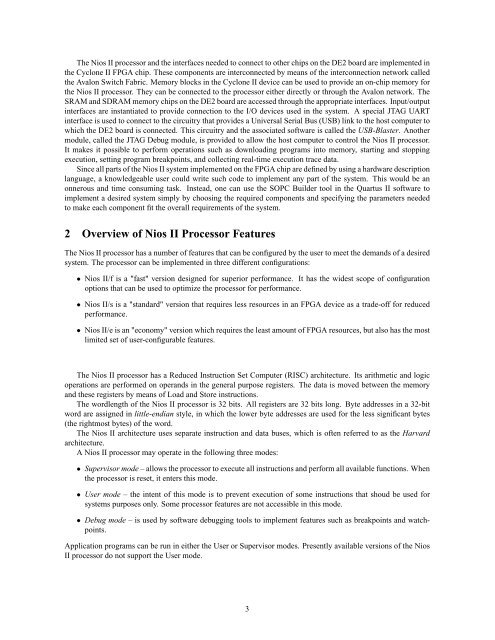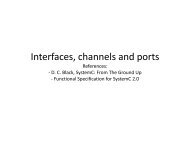Introduction to the Altera Nios II Soft Processor - FTP - Altera
Introduction to the Altera Nios II Soft Processor - FTP - Altera
Introduction to the Altera Nios II Soft Processor - FTP - Altera
Create successful ePaper yourself
Turn your PDF publications into a flip-book with our unique Google optimized e-Paper software.
The <strong>Nios</strong> <strong>II</strong> processor and <strong>the</strong> interfaces needed <strong>to</strong> connect <strong>to</strong> o<strong>the</strong>r chips on <strong>the</strong> DE2 board are implemented in<br />
<strong>the</strong> Cyclone <strong>II</strong> FPGA chip. These components are interconnected by means of <strong>the</strong> interconnection network called<br />
<strong>the</strong> Avalon Switch Fabric. Memory blocks in <strong>the</strong> Cyclone <strong>II</strong> device can be used <strong>to</strong> provide an on-chip memory for<br />
<strong>the</strong> <strong>Nios</strong> <strong>II</strong> processor. They can be connected <strong>to</strong> <strong>the</strong> processor ei<strong>the</strong>r directly or through <strong>the</strong> Avalon network. The<br />
SRAM and SDRAM memory chips on <strong>the</strong> DE2 board are accessed through <strong>the</strong> appropriate interfaces. Input/output<br />
interfaces are instantiated <strong>to</strong> provide connection <strong>to</strong> <strong>the</strong> I/O devices used in <strong>the</strong> system. A special JTAG UART<br />
interface is used <strong>to</strong> connect <strong>to</strong> <strong>the</strong> circuitry that provides a Universal Serial Bus (USB) link <strong>to</strong> <strong>the</strong> host computer <strong>to</strong><br />
which <strong>the</strong> DE2 board is connected. This circuitry and <strong>the</strong> associated software is called <strong>the</strong> USB-Blaster. Ano<strong>the</strong>r<br />
module, called <strong>the</strong> JTAG Debug module, is provided <strong>to</strong> allow <strong>the</strong> host computer <strong>to</strong> control <strong>the</strong> <strong>Nios</strong> <strong>II</strong> processor.<br />
It makes it possible <strong>to</strong> perform operations such as downloading programs in<strong>to</strong> memory, starting and s<strong>to</strong>pping<br />
execution, setting program breakpoints, and collecting real-time execution trace data.<br />
Since all parts of <strong>the</strong> <strong>Nios</strong> <strong>II</strong> system implemented on <strong>the</strong> FPGA chip are defined by using a hardware description<br />
language, a knowledgeable user could write such code <strong>to</strong> implement any part of <strong>the</strong> system. This would be an<br />
onnerous and time consuming task. Instead, one can use <strong>the</strong> SOPC Builder <strong>to</strong>ol in <strong>the</strong> Quartus <strong>II</strong> software <strong>to</strong><br />
implement a desired system simply by choosing <strong>the</strong> required components and specifying <strong>the</strong> parameters needed<br />
<strong>to</strong> make each component fit <strong>the</strong> overall requirements of <strong>the</strong> system.<br />
2 Overview of <strong>Nios</strong> <strong>II</strong> <strong>Processor</strong> Features<br />
The <strong>Nios</strong> <strong>II</strong> processor has a number of features that can be configured by <strong>the</strong> user <strong>to</strong> meet <strong>the</strong> demands of a desired<br />
system. The processor can be implemented in three different configurations:<br />
• <strong>Nios</strong> <strong>II</strong>/f is a "fast" version designed for superior performance. It has <strong>the</strong> widest scope of configuration<br />
options that can be used <strong>to</strong> optimize <strong>the</strong> processor for performance.<br />
• <strong>Nios</strong> <strong>II</strong>/s is a "standard" version that requires less resources in an FPGA device as a trade-off for reduced<br />
performance.<br />
• <strong>Nios</strong> <strong>II</strong>/e is an "economy" version which requires <strong>the</strong> least amount of FPGA resources, but also has <strong>the</strong> most<br />
limited set of user-configurable features.<br />
The <strong>Nios</strong> <strong>II</strong> processor has a Reduced Instruction Set Computer (RISC) architecture. Its arithmetic and logic<br />
operations are performed on operands in <strong>the</strong> general purpose registers. The data is moved between <strong>the</strong> memory<br />
and <strong>the</strong>se registers by means of Load and S<strong>to</strong>re instructions.<br />
The wordlength of <strong>the</strong> <strong>Nios</strong> <strong>II</strong> processor is 32 bits. All registers are 32 bits long. Byte addresses in a 32-bit<br />
word are assigned in little-endian style, in which <strong>the</strong> lower byte addresses are used for <strong>the</strong> less significant bytes<br />
(<strong>the</strong> rightmost bytes) of <strong>the</strong> word.<br />
The <strong>Nios</strong> <strong>II</strong> architecture uses separate instruction and data buses, which is often referred <strong>to</strong> as <strong>the</strong> Harvard<br />
architecture.<br />
A <strong>Nios</strong> <strong>II</strong> processor may operate in <strong>the</strong> following three modes:<br />
• Supervisor mode – allows <strong>the</strong> processor <strong>to</strong> execute all instructions and perform all available functions. When<br />
<strong>the</strong> processor is reset, it enters this mode.<br />
• User mode – <strong>the</strong> intent of this mode is <strong>to</strong> prevent execution of some instructions that shoud be used for<br />
systems purposes only. Some processor features are not accessible in this mode.<br />
• Debug mode – is used by software debugging <strong>to</strong>ols <strong>to</strong> implement features such as breakpoints and watchpoints.<br />
Application programs can be run in ei<strong>the</strong>r <strong>the</strong> User or Supervisor modes. Presently available versions of <strong>the</strong> <strong>Nios</strong><br />
<strong>II</strong> processor do not support <strong>the</strong> User mode.<br />
3

















